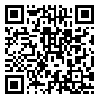Volume 2, Issue 2 (july 2018)
ohhp 2018, 2(2): 77-88 |
Back to browse issues page
Department of Occupational Health Engineering, School of Public Health, Ahvaz Jundishapur University of Medical Sciences, Ahvaz, Iran
Abstract: (2868 Views)
Introduction: In recent years, the importance of Compressed Natural Gas (CNG) has increased more than gasoline and petrol. Using this gas as a clean fuel to reduce air pollutants and restrictions on the supply of oil resources, has led to an increase in the expansion of its supply stations in the country. Therefore, this study aimed to investigate the methane release model at CNG fuel stations to provide the protection map around them.
Method: The present study is a case study .In this study, modeling of fire and explosion consequences has been done by using ALOHA software at one of the CNG stations in Ahvaz. In this modeling, various scenarios were examined; including creating fractures on pressurized methane tanks with diameters 0.01, 0.20 and 0.03 meters.
Results: The results of this study, by comparing different scenarios, showed that by increasing the diameter of the fracture, the range of thermal radiation would be enhanced at greater distances. The diameter of the fracture from 0.01 to 0.33 mm, in 10 kw / m2 has increased from 10 to 21 meters, respectively. Moreover, in flammable range of methane vapor, the concentration of 30,000 ppm is about 60% of the minimum explosive level (LEL), which ranges from 68.58 to 160 m.
Conclusion: The consequences of the explosion wave up to 160 meters and thermal radiation up to 21 meters are the most dangerous factor at CNG fuel stations that threatens employees and surrounding residential areas. Therefore, by considering the permitted distance of the residential areas, increasing safety actions, and preventing accidents around the fuel stations, casualties and accidents can be reduced.
Method: The present study is a case study .In this study, modeling of fire and explosion consequences has been done by using ALOHA software at one of the CNG stations in Ahvaz. In this modeling, various scenarios were examined; including creating fractures on pressurized methane tanks with diameters 0.01, 0.20 and 0.03 meters.
Results: The results of this study, by comparing different scenarios, showed that by increasing the diameter of the fracture, the range of thermal radiation would be enhanced at greater distances. The diameter of the fracture from 0.01 to 0.33 mm, in 10 kw / m2 has increased from 10 to 21 meters, respectively. Moreover, in flammable range of methane vapor, the concentration of 30,000 ppm is about 60% of the minimum explosive level (LEL), which ranges from 68.58 to 160 m.
Conclusion: The consequences of the explosion wave up to 160 meters and thermal radiation up to 21 meters are the most dangerous factor at CNG fuel stations that threatens employees and surrounding residential areas. Therefore, by considering the permitted distance of the residential areas, increasing safety actions, and preventing accidents around the fuel stations, casualties and accidents can be reduced.
Type of Study: Research |
Subject:
safty
Received: 2018/08/21 | Accepted: 2018/08/21 | Published: 2018/08/21
Received: 2018/08/21 | Accepted: 2018/08/21 | Published: 2018/08/21
| Rights and permissions | |
 |
This work is licensed under a Creative Commons Attribution-NonCommercial 4.0 International License. |


